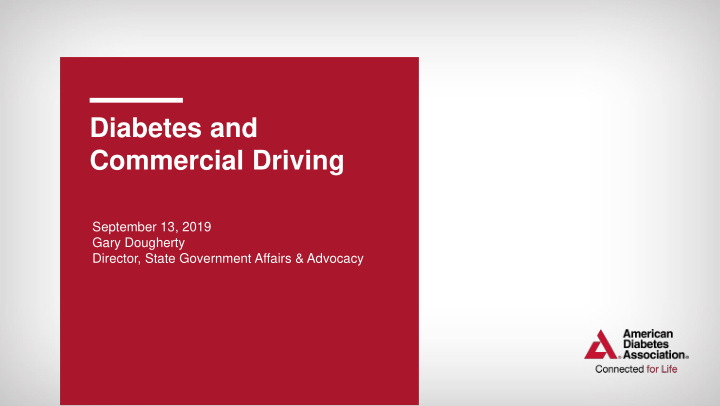



Diabetes and Commercial Driving September 13, 2019 Gary Dougherty Director, State Government Affairs & Advocacy
What is Commercial Driving?
Interstate vs. Intrastate Commercial Driving Two Notes: 1. Almost all commercial driving is interstate driving 2. Even if the driver is only driving a local route and not crossing state lines, if s/he is transporting goods/persons that came from or are going to another state, those are items of interstate commerce and the driving is interstate driving
Licensure: How it works Commercial Driver’s License • State issues the commercial driver’s license (CDL) • CDL required for vehicles weighing 26,001 pounds or more • State issues endorsements and places any necessary restrictions on CDL • Example: K restriction for intrastate-only operation
Licensure: How it works Medical Certification: Interstate • Required for certain commercial driving even if a CDL isn’t required • Vehicles weighing between 10,001-26,000 pounds; • Vehicles designed or used to transport more than 8 passengers for compensation; • Vehicles designed or used to transport more than 15 passengers, not for compensation; • Vehicles used to transport hazardous materials • For interstate commercial driving, the federal Department of Transportation (DOT) regulates medical certification • DOT Medical Cards are issued by individuals listed on the National Registry of Certified Medical Examiners
Licensure: How it works Medical Certification: Intrastate • State that issues the CDL may have its own medical requirements • Those state medical requirements may be more restrictive than the federal requirements, but cannot violate federal antidiscrimination law • Example: State does not allow anyone with ITDM to operate a school bus • Many state medical requirements track the federal requirements
Medical Certification: 1970-2003 U.S. Department of Transportation Federal Motor Carrier Safety Regulations contain an absolute prohibition on the use of insulin. Blanket Ban Anyone with type 1 diabetes or insulin-treated type 2 diabetes is not eligible to receive a DOT medical card. Regulations containing this blanket ban were written in 1970 and thus, based on 1970-era diabetes management.
Medical Certification: 2003-2018 The Federal Motor Carrier Safety Regulations remain static, but the Federal Motor Carrier Safety Administration (FMCSA) institutes a Diabetes Exemption Program , allowing medical Regulatory certification to some qualified individuals with insulin-treated Ban but diabetes. Exemption Program Exemption Program is burdensome and long wait to get approval discourages many from applying. Despite challenges, more than 4,000 individuals granted exemptions.
Medical Certification: Today In November 2018, FMCSA changed its regulation to allow medical certification of insulin-treated commercial drivers outside of an exemption program. Individual Assessment Under the new rule, a Treating Clinician assesses diabetes, including review of 3 months of blood glucose records, hypoglycemia history, A1C, and complications. Driver must provide at least 3 months SMBG records to receive 12-month DOT card. If <3 months records provided, may only receive 3-month DOT card.
Medical Certification: Today There is no specific A1C required for certification. Severe hypoglycemia is disqualifying until the Treating Clinician evaluates and determines the cause has been Individual addressed and the individual again has a stable insulin Assessment regimen and properly controlled ITDM. TC must complete a new assessment form for individual to resume driving. Severe non-proliferative diabetic retinopathy or proliferative diabetic retinopathy are permanently disqualifying.
Medical Certification: Today Treating Clinician must determine the driver has a “stable insulin regimen” and “proper control” of their ITDM. Once TC completes assessment, form and process moves Individual to certified medical examiner who makes final decision Assessment and issues the DOT medical card. Diabetes evaluation is captured on MCSA-5870 Insulin- Treated Diabetes Mellitus Assessment Form February 21, 2019: FMCSA formally withdraws the Diabetes Exemption Program
ADA Commercial Driving Advocacy
Crossing the Finish Line ADA goes to Congress to force the U.S. FMCSA publishes a Final Rule on ADA returns to Congress to fix Department of Transportation to study the diabetes in the Federal Register. the Diabetes Exemption Program. feasibility of licensing people with insulin-treat- Final Rule eliminates the blanket Legislation passes making it easier ed diabetes (ITDM). ban against insulin use that has to qualify for a diabetes exemption been in regulation since 1970. New ADA publishes a position and requiring FMCSA to establish a ADA volunteers Chris Saudek, MD, Ed Horton, rule allows drivers with ITDM to be statement on Diabetes & Driving in Medical Review Board to make MD, George Grunberger, MD, FACP , FACE, and assessed by a treating clinician and Diabetes Care recommendations on diabetes Michael Brennan, MD serve on an expert panel outside of an exemption program. to advise the government about diabetes. and other conditions. 2012 2018 2005 1998 2006 2015 2003 FMCSA establishes a Diabetes Expert Panel FMCSA publishes a Notice of Proposed The Federal Motor Carrier Safety to review data and provide recommenda- Rulemaking (NPRM). The proposed Administration (FMCSA) announces a tions to the agency. ADA volunteer Daniel rule eliminates the Diabetes Exemption new Diabetes Exemption Program Lorber, MD, FACP , CDE leads the Diabetes Program in favor of individual assessment allowing certain qualified individuals Expert Panel. Despite the panel ’ s expert by the driver ’ s treating clinician and cites with ITDM to operate commercial recommendations, the Medical Review extensively to ADA ’ s position statement. motor vehicles. Board rejects them in favor of their own proposals, which includes a restriction ADA activates its Diabetes Advocates to on people with ITDM being allowed to weigh in in support of the proposed rule. transport hazardous materials or FMCSA receives more than 1,200 public carry passengers. comments, 1 ,0 0 0 of which are from Diabetes Advocates. FMCSA publishes an Advanced Notice of Proposed Rulemaking seeking public input on a new diabetes rule.
RESOURCES American Diabetes Association: www.diabetes.org/CDL ADA Legal Advocate Program: 1-800-DIABETES / AskADA@diabetes.org Federal Motor Carrier Safety Administration: www.fmcsa.dot.gov ❑ MCSA-5870 Insulin-Treated Diabetes Mellitus Assessment Form: https://www.fmcsa.dot.gov/regulations/medical/insulin-treated-diabetes- mellitus-assessment-form-mcsa-5870 ❑ September 2018 Announcement and Publication of Final Rule: https://www.fmcsa.dot.gov/regulations/medical/federal-motor-carrier-safety- administration-fmcsa-eliminates-federal-diabetes ❑ New Diabetes Standard Overview Webinar: https://www.fmcsa.dot.gov/regulations/medical/new-diabetes-standard- overview-webinar
Recommend
More recommend